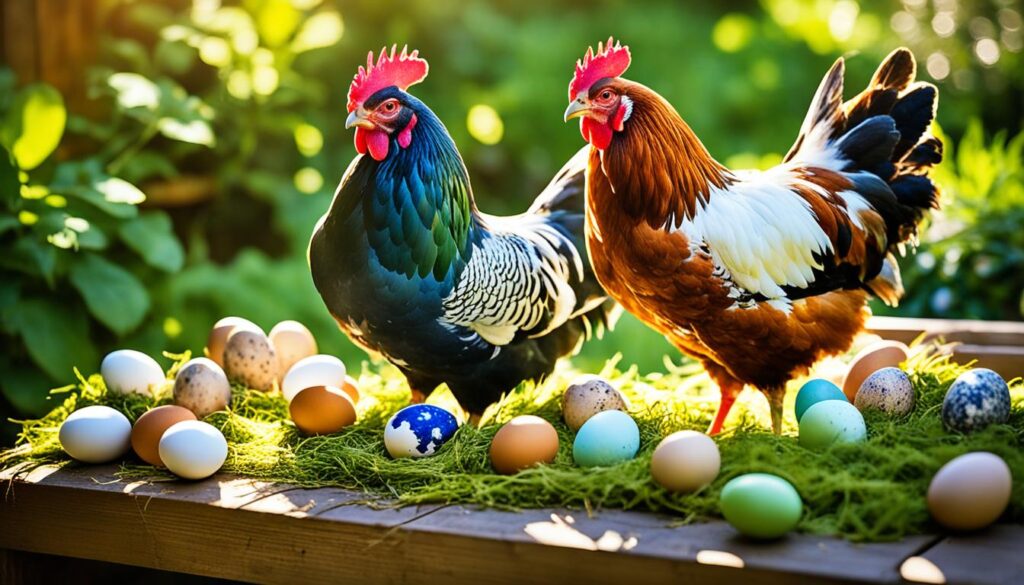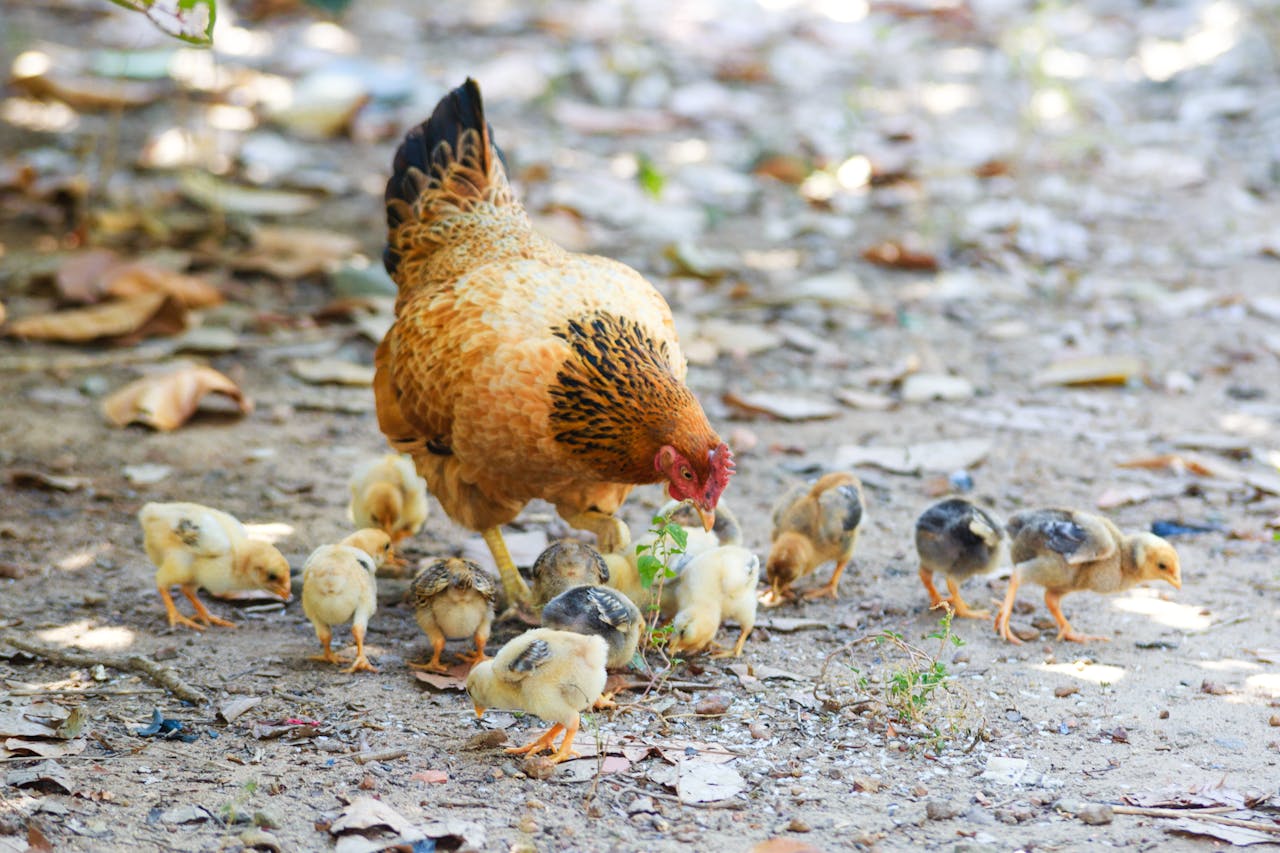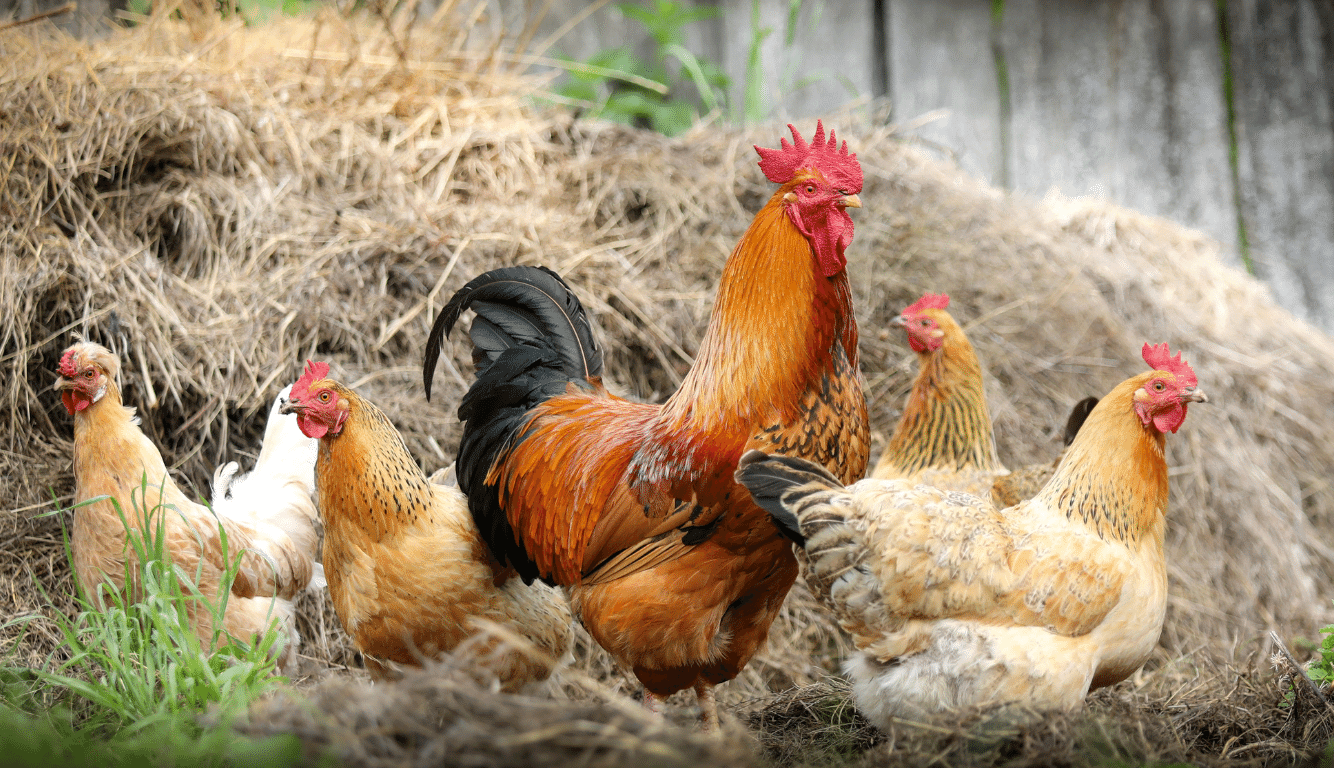Hello, fans of backyard chickens! If your chickens are having trouble laying eggs, you’re in the right spot. This article will talk about the common problems with egg laying in backyard chickens. I’ll give you useful tips to boost egg production.
Key Takeaways:
- Understanding the factors that affect egg production is crucial for maximizing output.
- Proper lighting and a stress-free environment are key to ensuring consistent egg-laying.
- Nutrition plays a vital role in maintaining optimal egg production.
- Managing natural cycles, such as molting and aging, is essential for maintaining a productive flock.
- Broodiness, water deprivation, stress, and disease can also impact egg-laying and should be addressed accordingly.
Factors Affecting Egg Production: Light and Environment
One main factor that affects egg production in backyard chickens is daylight. Hens need at least 16 hours of daylight for strong egg production. **Backyard chicken egg production troubles** happen when daylight hours drop, especially in fall and winter. During these shorter days, hens might lay fewer eggs or stop laying altogether.
To keep egg production consistent year-round and **maximize backyard chicken egg output**, use supplemental lighting. Adding artificial light to the coop can increase the light hens get each day. This makes up for less natural light and keeps egg production high.
But, the **coop environment** matters too in egg production. Stress in the coop can lower egg-laying in backyard chickens.
Aggressive hens, too many birds, poor food, and predators can hurt egg production. These issues can make the coop a bad place for hens, causing less or uneven egg laying.
To fix these problems and keep a healthy egg-laying flock, create a stress-free coop. This means **predator-proofing the coop**, giving hens enough space, having proper **nesting boxes**, and keeping the coop’s temperature right.
| Factors Affecting Egg Production | Impact on Egg-Laying |
|---|---|
| Lack of Sufficient Daylight | Decreased or halted egg production |
| Aggressive Hens | Stress and reduced egg-laying |
| Over-Crowding | Stress and decreased egg production |
| Poor Nutrition | Decreased egg-laying and poor egg quality |
| Predator Presence | Stress and reduced egg production |
By looking after **lighting** and **environmental factors**, backyard chicken keepers can avoid **backyard chicken egg production troubles**. This ensures a continuous supply of fresh eggs from their flock.
Nutritional Factors Affecting Egg Production
Proper nutrition is key for steady egg production in backyard chickens. To boost egg numbers, chickens must eat a diet that suits their nutritional needs.
One mistake chicken keepers often make is giving too many treats. While treats are fine now and then, too much can weaken their diet. This can lead to fewer eggs being laid.
Laying hens need a diet that is 90% complete layer feed. This feed gives them all the nutrients for more eggs. It has proteins, carbohydrates, fats, vitamins, and minerals.
Calcium is very important for making eggshells. Hens need about four grams of calcium daily for strong shells. Complete layer feeds give the right amount of calcium.
It’s important to limit treats and scraps. Too many treats can mess up the nutrient levels in the complete layer feed. This can cause a drop in egg numbers.
| Nutrient | Role | Sources |
|---|---|---|
| Protein | Supports egg production and feather growth | Layer feed, soybean meal, fish meal |
| Carbohydrates | Provides energy for overall health and egg production | Corn, wheat, barley |
| Fats | Essential for hormone production and nutrient absorption | Corn oil, vegetable oil, fish oil |
| Vitamins | Supports overall health and egg production | Green leafy vegetables, carrots, supplements |
| Minerals | Aids in eggshell formation and other vital functions | Calcium, phosphorus, magnesium |
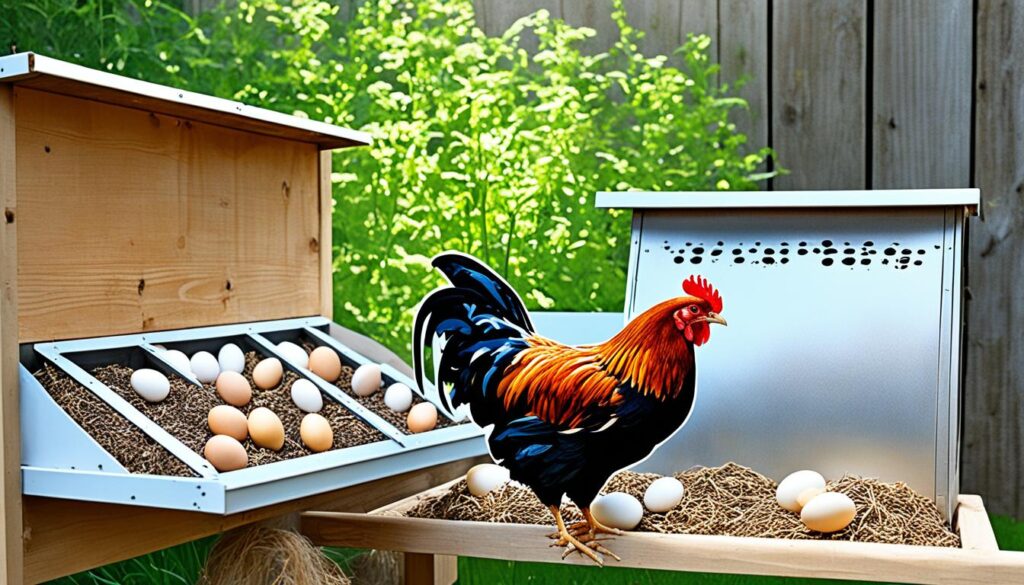
Keeping a well-balanced diet is crucial for a lot of eggs. Talking to a poultry expert can make sure your feed fits your flock’s needs. Watching what your hens eat and giving fewer treats can keep egg production high and chickens healthy.
Natural Causes of Decreased Egg Production
Egg production in backyard chickens can drop for natural reasons. Molting and the hen’s age are two big factors.
Molting: A Natural Process
Molting happens when chickens lose old feathers and grow new ones. This makes them use energy for growing feathers, not laying eggs. So, you might get fewer eggs for a while.
Molting usually happens once a year and can last several weeks. It often starts in late summer or early fall. During molting, you might see a big drop in egg production, or it may stop altogether.
To help your hens during molting, they need good food. A complete layer feed with all the nutrients for feather growth is important. Be patient; egg laying goes back to normal after molting ends.
Hen Age and Egg Production
Hens start laying eggs at 18-20 weeks old. They lay eggs throughout their lives. But, they lay the most eggs in their first year.
As hens get older, they lay fewer eggs. While some keep laying for years, expect fewer eggs. Giving them a balanced diet, plenty of water, and a calm place helps a lot.
Knowing about molting and aging helps you deal with fewer eggs. Good nutrition, a stress-free area, and realistic hopes are key. They help your chickens through these changes. This way, you keep getting fresh eggs from your flock.
Other Factors Affecting Egg Production
Lighting, nutrition, and natural cycles are key in egg production. But, other factors also play a role. It’s important to tackle these to keep egg production high.
Broodiness
A broody hen can lower egg production in the flock. She stops laying eggs to incubate them. This can make other hens broody too, reducing eggs further. To solve this, separate her until she’s ready to lay again.
Water Deprivation
Chickens need constant access to clean water for health and eggs. Not enough water causes dehydration and fewer eggs. Always refill their water to keep them hydrated.
Stress and Environmental Changes
Chickens get stressed by changes, affecting their egg-laying. This includes new feed, coop changes, weather changes, and new or lost flock members. A calm environment helps keep their egg production steady.
Disease and Parasite Infestations
Sick chickens or those with parasites lay fewer eggs. They use their energy to fight off the sickness. Watch your flock for any signs of illness or parasites. Act fast to deal with these issues.
Improving these factors boosts your chickens’ egg production. This ensures a steady flow of fresh eggs.
BroodinessHalts egg-laying and inspires broodiness in other hensWater DeprivationCan lead to dehydration and decreased egg productionStress and Environmental ChangesDisrupts egg-laying patternsDisease and Parasite InfestationsDiverts energy and resources, resulting in reduced egg production
Addressing Egg-Laying Challenges
To address egg-laying challenges in backyard chickens, we must take several actions. These actions will help ensure optimal egg production. Below are essential steps to follow:
Supplemental Lighting
Providing extra lighting is a great way to boost egg production. Chickens need at least 16 hours of daylight for strong egg-laying. With more lights in the coop, our hens get enough daylight all year round. This keeps egg production high no matter the season.
Maintaining a Stress-Free Coop Environment
The coop’s environment is key to egg production. Things like predators, overcrowding, and poor diet can lower egg production. To keep our chickens stress-free, we must keep predators away, ensure enough space, and control coop temperatures. Reducing stress helps in maximizing egg output significantly.
Ensuring Proper Nutrition
Good nutrition is crucial for better egg production. A balanced diet that meets their needs is important. Hens require a diet with at least 90% complete layer feed for all necessary nutrients, including calcium. Limit treats and always provide fresh water to keep egg production at its best.
Managing Natural Cycles
Natural factors like molting and age can affect egg production. Molting shifts the hens’ energy from laying eggs to growing feathers. During molting, expect a temporary drop in egg production. Plus, as hens get older, they naturally lay fewer eggs. Understanding and managing these cycles helps in optimizing egg output.
Addressing Other Factors
Other factors can also affect egg production, such as broodiness and health issues. Dealing with broody hens is necessary to keep egg production steady. Clean, fresh water is vital for forming eggs. Keeping chickens stress-free and healthy supports optimal egg production.
Implementing these solutions makes improving backyard chickens’ egg production easier. Regular checks and the right conditions for our flock mean maximum egg output and a thriving chicken community.
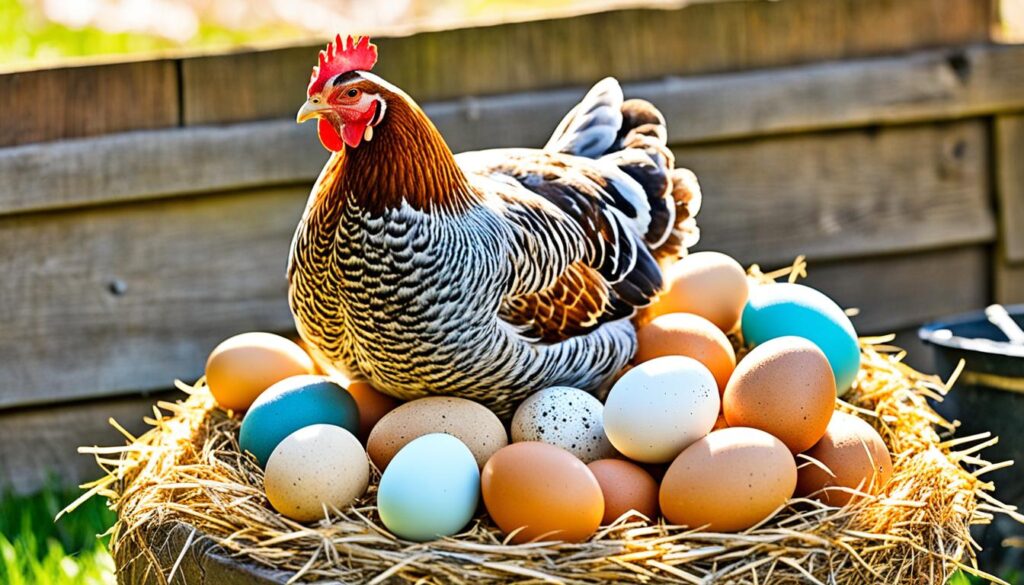
Conclusion
Maintaining consistent egg production in backyard chickens is crucial. It requires a good understanding of many factors that can affect their egg-laying. Providing the right lighting, coop setup, and nutrition is vital. Addressing natural cycles and challenges will also help improve backyard chicken egg laying problems.
Regular checks and proactive management are key. With the correct care, your chickens can continue giving you a steady flow of fresh eggs. This keeps your flock both productive and healthy.
To help with egg-laying challenges, ensure your hens get enough daylight. Use supplemental lighting for optimal egg production. A calm coop environment and a balanced diet, with fewer treats, aid in improving output. Tackle any health issues quickly to overcome backyard hen egg laying difficulties.
Implementing these steps will maximize backyard chicken egg output. A content and healthy flock means more eggs for you. Invest in the necessary resources and take proactive steps for the best results. The reward will be a plentiful supply of farm-fresh eggs right from your backyard!

